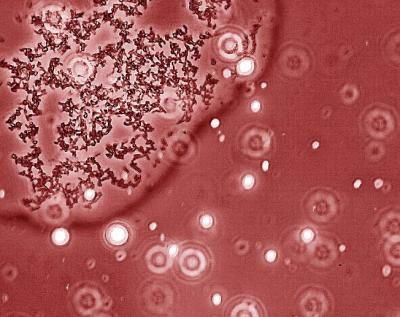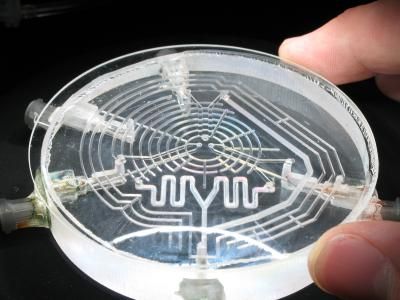Wacker Resumes Growth Course after the Crisis Year of 2009
Advertisement
Wacker Chemie AG forecasts substantial sales and earnings gains for the current year. The Munich-based chemical company reported that the upturn recently seen in its business fields is ongoing. After the global economic crisis sent customer demand plummeting in early 2009, sales volumes steadily recovered during the rest of the year. However, they did not attain 2008’s level. The volume decline – coupled with lower prices – brought consolidated sales down 14 percent to €3.72 billion in 2009 (2008: €4.30 billion).
Earnings fell even further. 2009’s earnings before interest, taxes, depreciation and amortization (EBITDA) decreased to €607 million (2008: €1.06 billion). The main cause was the weak trend in the Group’s semiconductor segment, where EBITDA dropped €520 million against 2008. Additionally, non-recurring charges reduced Wacker’s EBITDA by €160 million. These charges comprise investment expenses due to exiting the solar-wafer business, an addition to pension provisions, and provisions for additional phased-early-retirement quotas, for working-life accounts and for personnel measures at WACKER SILICONES and Siltronic. Moreover, earnings before interest and taxes (EBIT) were impacted by fixed-asset impairments totaling €176 million. Overall, Wacker’s net result for the year fell to €-75 million (2008: €438 million).
In the first two months of 2010, every division reported continuing sales-volume gains. In January and February, consolidated Group sales were higher compared both to the prior-year period and to the monthly average in Q4 2009. Provided that the rebound continues during the rest of the year, Wacker predicts that 2010’s sales will cross the four-billion-euro mark. Net income for the year, according to the latest forecasts, is expected to be substantially positive.
“Wacker reported a sound operating performance for 2009 and has resumed a growth trajectory,” said Group CEO Rudolf Staudigl this Wednesday in Munich. “Adjusted for non-recurring charges, we generated good EBITDA figures in every division apart from Siltronic. The demand recovery benefits not only our chemical divisions, but also our semiconductor activities. In our polysilicon segment, demand remains consistently high and we can sell our entire output on the market at attractive prices. Our Group’s financial condition remains extremely good and the global trends that drive product demand are unchanged. All these are fundamental factors to generate substantial sales and earnings growth this year.”
Investments
The Group’s investments stayed at a high level in 2009. Asset additions reached €740 million (2008: €916 million). The resulting investment ratio in relation to sales was 20 percent. Spending was mainly on production plants for polysilicon, siloxane and dispersible polymer powders.
2009’s primary investment focus was on expanding production capacities for hyperpure polycrystalline silicon. Wacker started up “Expansion Stage 8” in Burghausen. The facility should ramp to its planned nominal capacity of 10,000 metric tons annually during the second quarter of 2010. At Nünchritz, the construction of a new polysilicon plant also progressed well in 2009. It should come on stream before the end of 2011, again with an annual nominal capacity of 10,000 metric tons.
In Nanjing (China), Wacker officially opened a new polymers site last November. Here, the Group produces dispersible polymer powders and dispersions for the Chinese market – especially for the construction industry. With a polymer-powder capacity of 30,000 metric tons per year, the Nanjing plant is the largest of its kind in China. As a result, Wacker can now meet the rapidly accelerating demand for polymer powders – particularly for energy-saving building insulation – through local production facilities.
Employees
At the end of 2009, Wacker had 15,618 employees worldwide, 304 fewer than in 2008. The payroll decline stems from personnel measures to mitigate the effects of the economic crisis on the Group. On December 31, 2009, Wacker’s German sites had 11,925 employees and its international sites 3,693.
Net Cash Flow, Net Financial Liabilities and Equity Ratio
In 2009, net cash flow was €-33 million, down €55 million (2008: €22 million). The decrease was mainly due to the Group’s substantially reduced net result for the year, to lower advance customer payments against 2008, and to the continued high level of investments in strategic growth projects. Net financial liabilities were €76 million on December 31, 2009. In 2008, there had been a liquidity surplus of €33 million. The Group’s total assets on December 31, 2009 were only slightly lower than at the end of 2008, dropping by just under 2 percent to €4.54 billion (2008: €4.63 billion). On the reporting date, equity amounted to €1.94 billion (2008: €2.08 billion). The main reason for the decline was the net loss recognized for the year. As a result, the equity ratio was 42.8 percent (2008: 45.0 percent).
Business Divisions
In 2009, sales at Siltronic were €638 million, 53 percent below the previous year (2008: €1.36 billion). The primary hurdles were weak semiconductor-sector demand for silicon wafers and a decline in sales of silicon monocrystals and other materials to the solar industry. Additionally, continued price pressure for all wafer diameters burdened Siltronic’s business. 2009’s divisional EBITDA was €-162 million (2008: €357 million). As announced in early July 2009, Siltronic has introduced a lead-site strategy to optimize production and make it more flexible, cut costs and boost productivity. Siltronic is pushing ahead with customer qualification of the wafers produced at its designated lead sites so that it can meet customer needs from these locations in the future.
In 2009, total sales at WACKER SILICONES were down on the prior-year level – dropping 12 percent to €1.24 billion (2008: €1.41 billion). After a weak start to 2009, sales began to rise from the second quarter onward. The gains during the year, however, did not fully compensate for the considerable shortfall back in Q1. Demand weakness left some production capacities underutilized. On the EBITDA front, the downtrend was less pronounced. At €158 million (2008: €168 million), EBITDA fell 6 percent against 2008. Earnings profited from cost savings and lower energy and raw-material costs, but were hampered by reduced sales volumes and increased price pressure.
WACKER POLYMERS’ total sales declined in 2009, too – down 14 percent to €744 million (2008: €868 million). The main reason was lower sales volumes for dispersible polymer powders and dispersions. The division, however, improved its EBITDA, which reached €117 million (2008: €109 million). While earnings benefited from cost-savings and lower energy and raw-material costs, they were impeded by weaker prices.
WACKER POLYSILICON again generated sales gains in 2009. Up 35 percent to €1.12 billion (2008: €828.1 million), total sales crossed the billion-euro mark for the first time. Growth was fueled by additional Burghausen production volumes, which were successfully placed on the market. Polysilicon output rose over 50 percent from 2008, reaching 18,100 metric tons. Divisional EBITDA also climbed substantially. At €521 million, it rose a good 23 percent against the previous year (2008: €422 million). One factor weighing on EBITDA was Wacker’s exit from the WACKER SCHOTT Solar (WSS) joint venture. The pro rata loss and exit-related expenses reduced WACKER POLYSILICON’s investment result by €52 million. On top of this, lower polysilicon prices for short-term deliveries hampered business in 2009. Moderate operating costs and high capacity utilization, though, bolstered the full-year earnings trend.
In 2009, WACKER FINE CHEMICALS increased total sales by over 7 percent to €105 million (2008: €98 million). Growth was largely driven by its gumbase business, which was transferred from WACKER POLYMERS to WACKER FINE CHEMICALS effective July 1, 2009. This reorganization has strengthened the division’s food and food-supplements business. EBITDA reached €10 million, up 8 percent year over year (2008: €9 million). The division intensified its focus on biotechnology. As of January 1, 2010, it has also changed its name to WACKER BIOSOLUTIONS.
Outlook
After the sharp downturn of late 2008 and early 2009, the world economy is back on a moderate growth path. According to analysts, this upturn will continue during the current year. The trend, Wacker anticipates, will be somewhat subdued in Europe and the USA. The outlook for Asia is quite different. Gross domestic product there is expected to grow strongly, especially in China.
The semiconductor-market recovery will continue in 2010, positively affecting plant utilization and probably prices, too. Wacker assumes that these trends will enable Siltronic to generate sales growth. At the same time, Wacker will press on with its efforts to increase productivity and cut costs in its semiconductor segment. To do this, Wacker continues to focus on Asia which is the largest wafer market and has prioritized greater production-process flexibility. The goal is to counter demand fluctuations by utilizing capacities fully at the sites with the best cost structures. Consequently, Siltronic introduced a new lead-site strategy in mid-2009. As a result, it has discontinued 150 mm wafer production at Freiberg and transferred these production volumes to Burghausen. In the 300 mm wafer segment, Siltronic is focusing production at Freiberg and Singapore. Singapore is also the lead site for 200 mm wafers. Siltronic plans to additionally improve its productivity via a further reduction of its overhead costs.
WACKER SILICONES’ sales revenues are expected to climb in 2010. Growth will mostly stem from Asia, where demand for silicone products will continue to rise. At WACKER POLYMERS, sales-volume should increase in 2010, with Asia again as the fastest-growing market. WACKER BIOSOLUTIONS’ full-year sales revenues are expected to grow at a double-digit percentage rate.
Wacker expects that its hyperpure polycrystalline silicon business will experience further growth on both the production-volume and demand sides. During the second quarter of 2010, the Group intends to ramp up Burghausen’s “Expansion Stage 8” to its planned nominal capacity of 10,000 metric tons annually. Similarly, Wacker will press on with building its new polysilicon plant at Nünchritz. As a global quality and cost leader, Wacker sees good opportunities for its polysilicon business to generate continued, profitable growth, even amid decreasing prices. Additionally, WACKER POLYSILICON has secured a large part of its polysilicon production volumes through long-term agreements. In total, Wacker plans to invest between €600 million and €700 million during the current year – the lion’s share being for ongoing polysilicon expansion projects.
Provided that the economic upturn continues for the rest of the year, Wacker expects consolidated sales to cross the four-billion-euro mark in 2010. From today’s vantage point, net income for the year should be substantially positive.

























































